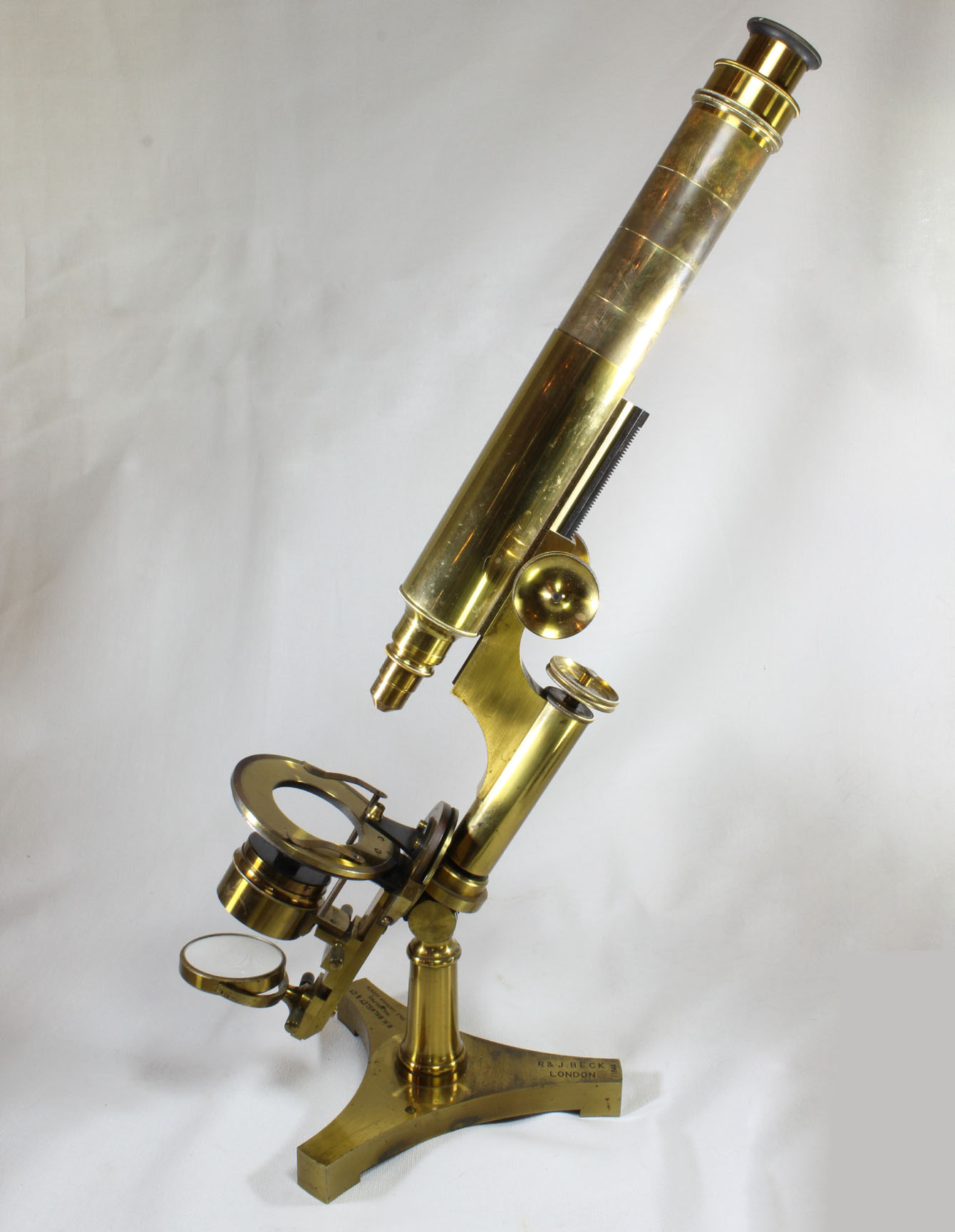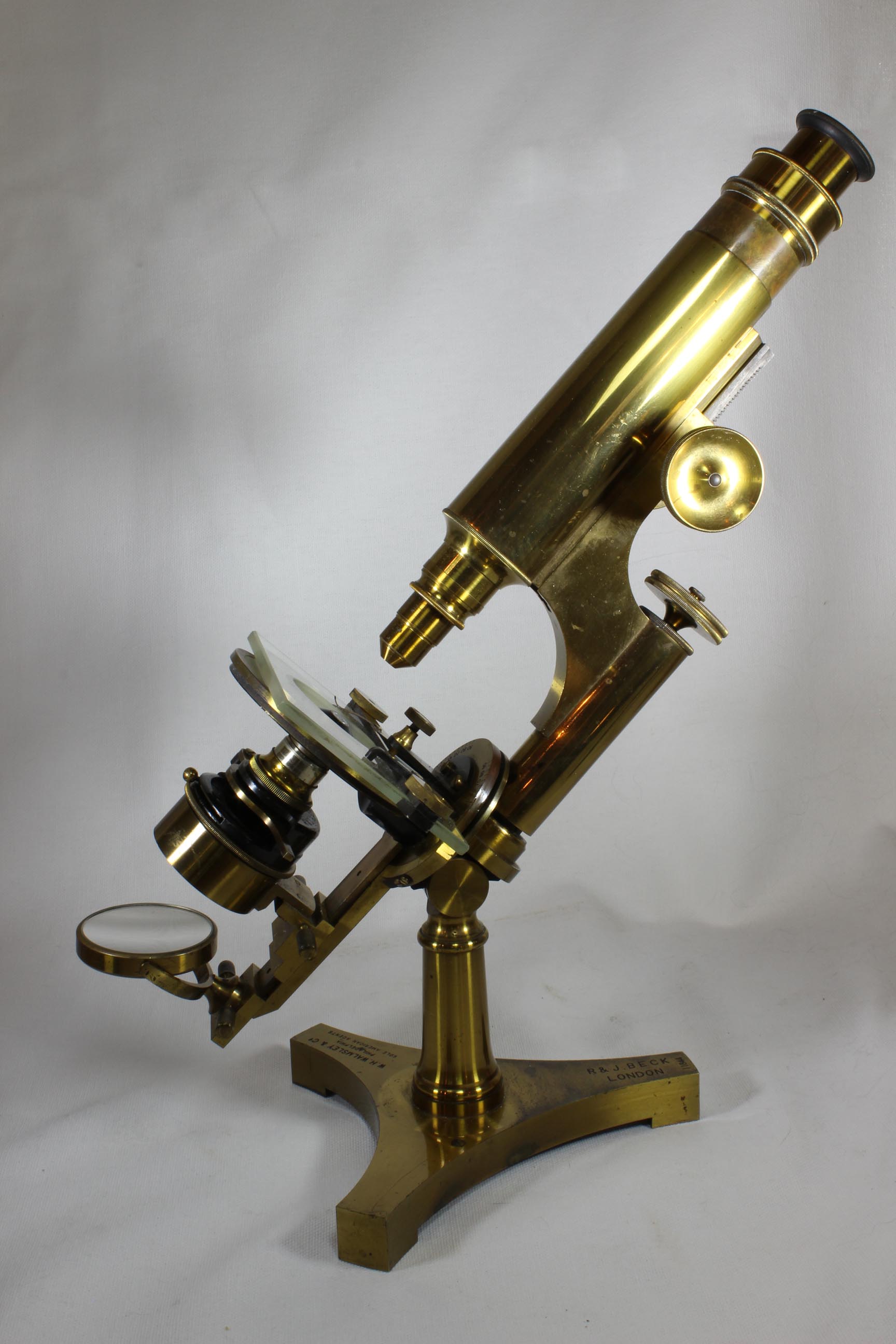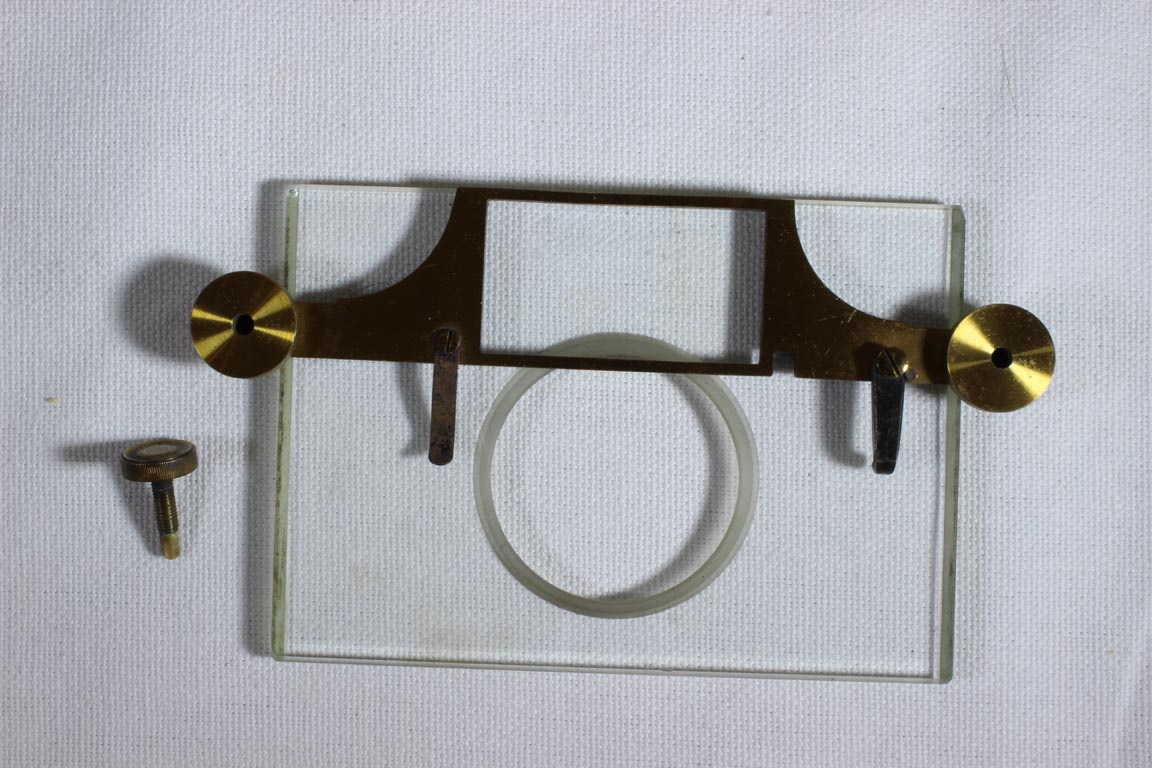MAKER: R. AND J. BECK
MODEL: 'IDEAL'
c. 1881
SIGNED:'W.H. WALMSLEY & Co, PHILADELPHIA, SOLE AMERICAN AGENTS' on one toe of the flattened tripod foot, and 'R & J BECK, LONDON' on another toe
SERIAL NUMBER: 11844
Please Click On Any Picture for a Larger Version
DESCRIPTION:


This uncommon microscope, often confused with the Beck 'Economic' model, arises on moderately short single pillar from a flat tripod to an inclination joint. The continental limb attaches at its bottom to the sector and thin stage. The large sector is calibrated 0 to 90 degrees on each side, with divisions every five degrees and
numbers every ten. An adjustable pressure pin support screws into this
sector to allow a gliding slide support to be used. The large but thin
circular stage has a large diameter central opening. The underside of
the stage is covered with a slightly raised, polished black hard rubber
material (Ebonite) to facilitate use of slides on that surface. (A
slightly lower serial numbered stand has no rubber on the bottom of the
stage which is instead painted black.) Two holes on the stage allow the
use of stage clips with long pegs either from above in the traditional
manner, or below on the underside of the stage, thus
allowing even more oblique illumination. The single tailpiece rotates
through the axis of the stage, and can rotate above the stage for top
lighting. On it is a sliding condenser fitting and below that a sliding
support for the plane and concave mirror attached by a gimbal.
The
standard 'condenser' is nothing more than an aperture, but can be
removed to allow use of a more sophisticated lensed condenser, as shown to the right. There is
a single objective and single ocular.
The main
optical body tube has straight rack and pinion coarse focusing, and
fine screw fine-focusing through the continental limb. There is a
single draw tube (left), which has calibration markings every inch. The nosepiece is not sprung.
 In addition to stage clips, a sliding glass slide
support was supplied as an option and is shown here with the
instrument. The glass slide-holder has a central opening the same size
as the brass stage. The edges of the glass are are beveled. The brass
part of the glass slide support has angled grips, dovetailing into the beveled edges of the glass. This brass part can be tightened
or loosened by knurled knobs, securing the brass to the glass. Each of these knobs has a hole for accepting a stage forceps. A large
rectangular cutout in the brass allows the pressure point to work on
the glass surface. The knurled knob that engages the glass slide
support has an ivory tip. The pressure can be varied to allow the glass
support to slide easily or be held in a stationary position. On the
slide support is a small single stage clip on the right, and a stop on
the left for registering the edge of a slide or Maltwood finder.
Two of the middle images above show a comparison of the 'Ideal' with the 'Economic' model; click on those images for an enlarged comparison.
In addition to stage clips, a sliding glass slide
support was supplied as an option and is shown here with the
instrument. The glass slide-holder has a central opening the same size
as the brass stage. The edges of the glass are are beveled. The brass
part of the glass slide support has angled grips, dovetailing into the beveled edges of the glass. This brass part can be tightened
or loosened by knurled knobs, securing the brass to the glass. Each of these knobs has a hole for accepting a stage forceps. A large
rectangular cutout in the brass allows the pressure point to work on
the glass surface. The knurled knob that engages the glass slide
support has an ivory tip. The pressure can be varied to allow the glass
support to slide easily or be held in a stationary position. On the
slide support is a small single stage clip on the right, and a stop on
the left for registering the edge of a slide or Maltwood finder.
Two of the middle images above show a comparison of the 'Ideal' with the 'Economic' model; click on those images for an enlarged comparison.
HISTORY OF THE IDEAL MICROSCOPE
This model, called the 'Ideal' model, was first reported and
figured in the 1881 volume 5 of the JRMS, on pages 805-807. It is sometimes confused with the simpler and much more common Beck 'Economic' model,
which does not have a sector substage, and is shown in comparison above and also on the Ideal and Economic Comparison page. This microscope incorporates a
swinging tailpiece, the angle of which registers clearly on the
'sector'. A similar microscope was also made by Sidle and Poalk (after
suggestions from J. E. Smith at the Microscopical Congress of 1878)
marketed as the 'Acme' brand and a later modified version as the 'Acme
No. 3' sold by Queen and Co. Interestingly, the suggestion of putting
the stage clips under the stage to allow further oblique illumination
than possible when the slide is on top, was also a suggestion for the
original Acme microscope (as described by JE Smith in 'How to See with
the Microscope, 1880). A similar sector microscope was also made by
Robert Tolles. Many other makers produced the swinging substage in
other variations, and examples on this website which either have the
degrees engraved on the edge of the rotating ring, or simply rotate
with no calibrations, include those by Bulloch, Bausch & Lomb,
Ross, Zentmayer, and others.
The first person to
popularize a method in which the swinging substage did
not have to be refocused as it swings, was the famous American
microscope maker, Joseph Zentmayer. By having its axis of rotation at
the plane of the slide, the substage condenser focus was maintained throughout the range of obliquity; ironically, the condenser focus often could not be maintained due to obstruction by the stage. Zentmayer received his
American patent for this design in 1876. This design was swiftly copied by several English and American makers as seen here. The craze for
extreme oblique illumination via a swinging substage continued for a
relatively brief period of time. Perhaps the most extreme version of
oblique illumination can be seen in the 'Radial' microscope
made by Ross (under Wenham's direction). This method of oblique
illumination was soon abandoned in favor of much simpler methods such as using an
offset of the condenser or a stop with an offset opening. As mentioned
above, some models had the underside of the stage simply polished and
painted black while this example had a piece of polished hard rubber on
the bottom surface; either would suffice to hold a slide under the stage for maximally oblique illumination.
Parenthetically, the concept of a gliding slide-holder
with a glass surface on which the pressure pin registers, was also the
invention of Zentmayer. In its original form, the slide support was
made of brass with only the 'window' being made of glass, contacting
the pressure pin. This contrasts with the Beck design where the majority of the stage is made of glass with a brass piece attached. The original form of that stage can be seen on the 'Grand American' Model in this collection.


 In addition to stage clips, a sliding glass slide
support was supplied as an option and is shown here with the
instrument. The glass slide-holder has a central opening the same size
as the brass stage. The edges of the glass are are beveled. The brass
part of the glass slide support has angled grips, dovetailing into the beveled edges of the glass. This brass part can be tightened
or loosened by knurled knobs, securing the brass to the glass. Each of these knobs has a hole for accepting a stage forceps. A large
rectangular cutout in the brass allows the pressure point to work on
the glass surface. The knurled knob that engages the glass slide
support has an ivory tip. The pressure can be varied to allow the glass
support to slide easily or be held in a stationary position. On the
slide support is a small single stage clip on the right, and a stop on
the left for registering the edge of a slide or Maltwood finder.
Two of the middle images above show a comparison of the 'Ideal' with the 'Economic' model; click on those images for an enlarged comparison.
In addition to stage clips, a sliding glass slide
support was supplied as an option and is shown here with the
instrument. The glass slide-holder has a central opening the same size
as the brass stage. The edges of the glass are are beveled. The brass
part of the glass slide support has angled grips, dovetailing into the beveled edges of the glass. This brass part can be tightened
or loosened by knurled knobs, securing the brass to the glass. Each of these knobs has a hole for accepting a stage forceps. A large
rectangular cutout in the brass allows the pressure point to work on
the glass surface. The knurled knob that engages the glass slide
support has an ivory tip. The pressure can be varied to allow the glass
support to slide easily or be held in a stationary position. On the
slide support is a small single stage clip on the right, and a stop on
the left for registering the edge of a slide or Maltwood finder.
Two of the middle images above show a comparison of the 'Ideal' with the 'Economic' model; click on those images for an enlarged comparison.